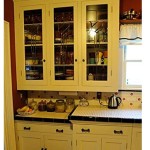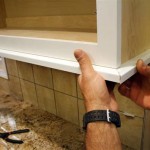Is It Best To Tile Under Kitchen Units?
When renovating or designing a kitchen, the decision of whether to tile under the cabinets is a common point of contention. While aesthetics play a significant role, functionality and practicality should also be considered. This article will explore the pros and cons of tiling under kitchen units to help you make an informed decision.
Advantages of Tiling Under Kitchen Units
There are several advantages to tiling under kitchen units, primarily stemming from the material's inherent characteristics:
- Enhanced Durability: Tiles are known for their robustness and resistance to scratches, stains, and impacts. They can withstand the wear and tear of spills, food splatters, and everyday use, making them a practical choice for a high-traffic area like a kitchen.
- Easy Cleaning: The smooth surface of tiles repels dirt and grime, facilitating effortless cleaning. A simple wipe with a damp cloth is often sufficient to maintain their pristine appearance.
- Water Resistance: Tiles are impervious to moisture, making them a suitable choice for areas prone to spills and splashes. This is particularly important in kitchens where water is often used for cooking and cleaning.
- Aesthetic Appeal: Tiles offer a wide variety of colors, patterns, and textures, allowing you to create a unique and stylish kitchen design. They can complement the cabinetry, backsplash, or other elements of the room, adding a touch of sophistication and personality.
Disadvantages of Tiling Under Kitchen Units
Despite their advantages, tiling under kitchen units also comes with some drawbacks:
- Installation Cost: Tiling is a labor-intensive process, leading to higher installation costs compared to other materials such as vinyl flooring or laminates. The cost can be further elevated with the need for additional materials like grout and sealant.
- Potential for Grout Discoloration: Over time, grout can become discolored due to spills and grime, especially in high-traffic areas. Regularly cleaning and sealing the grout can minimize this issue, but it does require maintenance.
- Floor Level Issues: Tiling under the cabinets can raise the floor level, making it difficult to install appliances or cabinets that are designed for a specific height. This can also create a noticeable transition between the tiled and non-tiled areas of the kitchen.
- Potential for Uneven Surfaces: If the subfloor is not perfectly level, the tile installation may result in uneven areas, creating a tripping hazard or affecting the aesthetics of the kitchen.
Alternatives to Tiling Under Kitchen Units
Instead of tiling, other options can create a practical and visually appealing kitchen floor:
- Vinyl Flooring: Vinyl flooring is a cost-effective and easy-to-install alternative to tiles. It comes in various styles and colors, mimicking the look of wood, stone, or even tile. Its water-resistance and durability make it a suitable choice for kitchens.
- Laminate Flooring: Laminate flooring is another popular choice for kitchens. It is scratch-resistant, easy to clean, and available in a range of designs. However, it may not be as water-resistant as vinyl flooring.
- Luxury Vinyl Plank (LVP): LVP is a more premium option that offers a realistic wood or stone look. It is highly durable, waterproof, and easy to install, making it a good investment for a kitchen.
Ultimately, the decision of whether to tile under kitchen units depends on your personal preferences, budget, and the specific needs of your kitchen. Carefully weighing the advantages and disadvantages of each option will lead to a well-informed and satisfying choice.

Should You Install Tile Floor Before Or After Cabinets
.jpg?strip=all)
Should You Install Tile Under Cabinets

Should You Install Tile Floor Before Or After Cabinets

Should You Install Tile Floor Before Or After Cabinets
.jpg?strip=all)
Should You Install Tile Under Cabinets

Can You Replace Kitchen Flooring Without Removing Cabinets

Should You Install Tile Floor Before Or After Cabinets

Top 5 Kitchen Layout Ideas And Tile Designs For Perfection

50 Kitchen Tile Ideas Tilesporcelain

Kitchen Tile Costs Which Type Is Best For My Budget Homes Gardens








